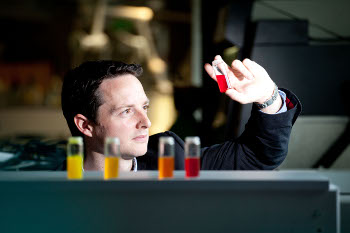Aug 23 2012
Research led by the Materials and Surface Science Institute (MSSI) at the University of Limerick has developed a cost effective solution to generate innovative solar energy conversion materials. The research project recently received further government support through a €700,000 Science Foundation Ireland grant.
 Dr Kevin M Ryan at the Materials and Surface Science Institute (MSSI), University of Limerick. Image Credit: Alan Place, Press 22.
Dr Kevin M Ryan at the Materials and Surface Science Institute (MSSI), University of Limerick. Image Credit: Alan Place, Press 22.
The solar industry is worth over €100 billion globally and is the fastest growing energy sector. Despite this, the world's energy requirements which are currently met by solar is less than 1%, which is primarily due to the high cost of production of efficient photovoltaic cells.
Current silicon-based commercial solar cells are very costly to process whereas alternative technologies rely on toxic materials such as cadmium or tellurium.
The most sought after materials currently for solar energy conversion are copper-indium-galium-disulfide (CIGS) and di-copper-zinc-tin-tetrasulphide (CZTS). By combining the four elements in each material in the correct combination, very high conversion of solar energy to electricity can be obtained. CIGS cells have shown the highest possible efficiencies whereas CZTS though marginally lower are regarded in the industry as being equally attractive for large scale commercialisation as each of the elements are in high natural abundance. The barrier to application is that current methods of making these materials requires very expensive technologies.
Lead researcher, Dr Kevin M Ryan, explains; "This technology has significant impacts for energy generation world-wide. We have developed a low-cost laboratory method of forming both CIGS and CZTS in nanorod form which can maximise solar absorption. 250 billion of these rods for example will fit on the head of a pin and our technology essentially allows us process these as an ink to form densely packed forests of these nanorods over very large areas optimised to harness the abundant solar power available."
This research was funded by Science Foundation Ireland (SFI) through the principal investigator programme to Dr Kevin Ryan and also through funding from the SFI Strategic Research Cluster in Solar Energy Conversion involving University of Limerick, UCD and DCU. For further information go to www.ifnano.com.